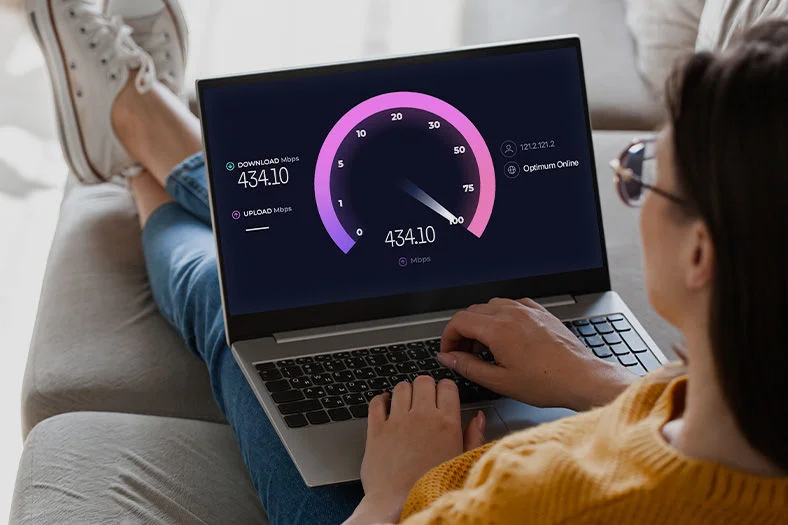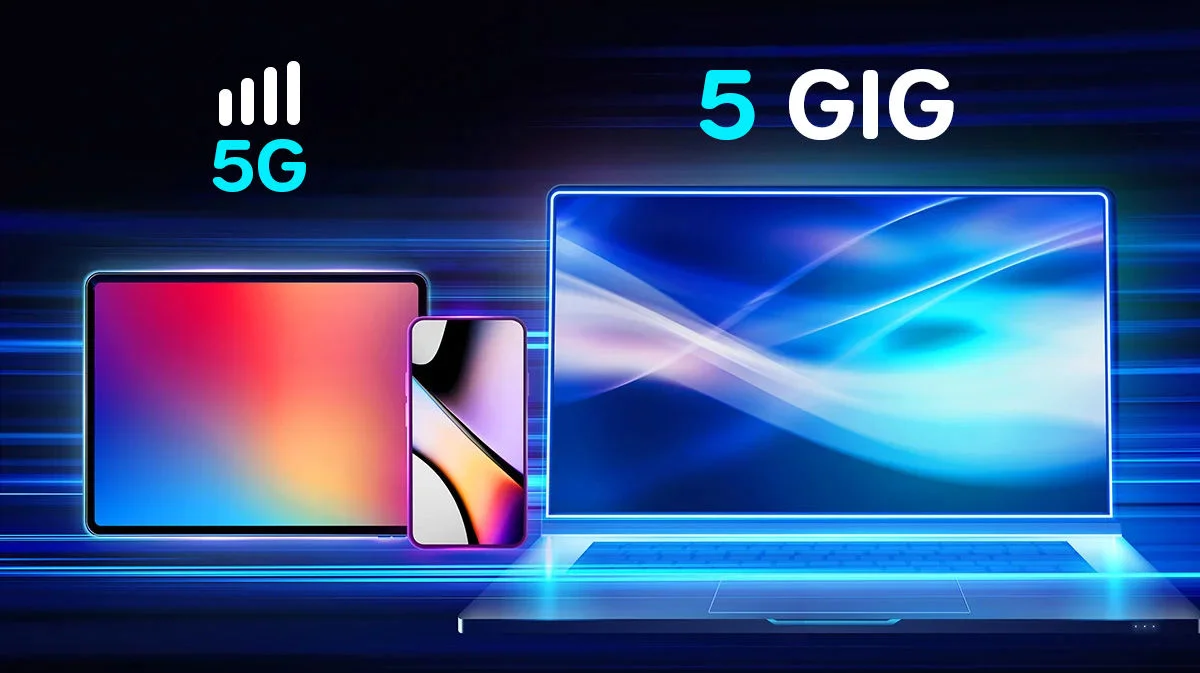What Is a WiFi Hotspot & How Does It Work?
By: Vincent Totino
Read Time: 13 min.
July 10, 2025
Long gone are the days when you had to be at home to access the internet. Today, you can stay connected from nearly anywhere, thanks to a growing range of WiFi options. For many people, having access to a reliable connection while on the go isn’t just a convenience; it’s a necessity.
Sure, you can check email or browse social media using public WiFi, but not every task is well-suited to public WiFi networks. If you're working remotely from a café or traveling through an airport, you may find that the wireless connection is too slow or unsecured. That’s where WiFi hotspots come in.
Whether you're using your phone's hotspot or a standalone device, hotspots let you create a wireless network and share internet access with other WiFi-enabled devices. This gives you access to fast, flexible connectivity wherever you are.
In this article, we’ll explain what a WiFi hotspot is, how it works, the types of hotspots available, and how to choose the right option based on your data needs.

What is a Wi-Fi hotspot?
A WiFi hotspot is a physical location or a device that allows WiFi-enabled devices to connect to the internet through a wireless local area network. These hotspots can be found in both public and private places like coffee shops, libraries, or even your smartphone and offer an easy way to get online without needing a fixed home internet connection.
A hotspot lets you create a WiFi network by pulling data from a cellular provider or wired connection, then sharing it with nearby mobile devices such as laptops, tablets, or smartphones.
Whether you are using a phone's hotspot feature or a dedicated device, hotspots are ideal for staying connected when you're away from home.
What Is a WiFi Hotspot?
Types of WiFi Hotspots
Not all WiFi hotspots are the same. Depending on your location, data needs, and the number of devices connected, you may prefer one type over another.
Most hotspots fall into three main categories:
Mobile Hotspots
A mobile hotspot turns your smartphone into a wireless network that shares your cellular data connection with other devices. This feature is often found under your phone’s settings and lets you use your phone as a personal hotspot wherever you have mobile coverage.
For example, you might connect your laptop to your phone’s hotspot to access a WiFi connection while traveling. The data used comes directly from your mobile plan, so it’s important to understand how hotspot data is counted in your plan.
Some providers include limited hotspot capabilities, while others offer unlimited data with restrictions after a certain amount of data usage.
Standalone Hotspot Devices
Standalone or external hotspots are portable devices you can purchase through a cellular provider. They function as dedicated routers by creating a wireless access point using 4G or 5G networks. These are especially helpful for people who need to connect more devices at once or prefer not to use their phone’s battery or data.
However, these devices often require a monthly fee, a separate hotspot data plan, and sometimes a contract. Some can even be connected via USB cable for direct access, while others rely solely on wireless transmission. They're ideal for users with heavy data needs, like remote workers or frequent travelers.
Public WiFi Hotspots
You’ve probably used one of these before in a coffee shop, airport, or hotel. Public WiFi hotspots offer free WiFi access in a physical location, but can have many limitations. These networks can be slower, less secure, and shared by many people.
If you're using public hotspots, it’s best to take precautions like using a virtual private network (VPN) and avoiding sensitive transactions. For more consistent access, Optimum customers can also connect to secure Optimum WiFi hotspots across the Tri-State area or partner networks while traveling.
Drawbacks of Standalone Hotspot Devices
Cost
How Does a WiFi Hotspot Work?
A WiFi hotspot works by turning a wireless device, like your smartphone or a dedicated hotspot unit, into a source of internet access. It pulls data through a cellular network (such as 4G or 5G) and rebroadcasts it as a wireless local area network that nearby WiFi-enabled devices can join.
When you activate your phone’s hotspot via your phone’s settings, you create a small WiFi network with its network name (also called an SSID or Service Set Identifier) and password. Other mobile devices like laptops or tablets can connect to this network the same way they would connect to your home internet.
For standalone hotspots, the process is similar. The device uses a SIM card and hotspot data plan from your cellular provider to deliver a secure connection. It then creates a portable WiFi access point, often allowing multiple devices connected at the same time. Some advanced models can even deliver faster speeds or offer longer battery life for all-day use.
No matter which type you use, the key benefit is mobility. Whether you’re commuting, working remotely, or on vacation, a hotspot can keep your mobile devices connected without relying on public WiFi networks.
Limited data availability and speed
Battery consumption
Network stability
Security risks
Costs, Data Plans, and Limitations of Hotspots
The initial cost of purchasing a standalone mobile hotspot device can be a drawback for some users.
The average cost for a basic standalone device without a contract ranges from $50 to $300. In addition to the device cost, you need a separate hotspot data plan to access the Internet, which is offered by your cellular provider. These monthly fee-based plans vary depending on how much hotspot data is included and whether the plan supports unlimited data or has a limit.
For users who don’t need to connect more devices or want a simpler solution, your phone’s hotspot should be enough. With many unlimited data plans, you can get a set amount of hotspot capabilities at high speeds before throttling occurs. Optimum Mobile, for example, includes mobile hotspot access in all its plans, and you can share your WiFi connection wherever you have coverage.
Standalone hotspot plans often come with data limits, after which speeds may be significantly reduced. This can make internet activities like video streaming or file downloads slow and frustrating. Also, the more devices connected, the slower the overall speed.
Consider Optimum Mobile and Optimum WiFi Hotspots
Benefits of Optimum Mobile and Optimum WiFi Hotspots Over Mobile Hotspot Devices
Cost-effectiveness
Unlimited, high-speed data
Reliable and secure connection
Performance and Battery Life Considerations
Standalone mobile hotspot devices often have limited battery life. Without access to a power source, these devices may drain quickly and not last through a full workday.
Android phones and other smartphones often include power-saving features that extend battery life when using the phone’s hotspot. However, prolonged use can still impact your device’s performance.
Another factor to consider is network congestion. In busy areas, network bandwidth may be limited due to high usage. As a result, even with a strong signal, your wireless connection may slow down significantly. You’ll require faster speeds for activities like video calls or large downloads.
To ensure a reliable connection, make sure to monitor your data needs and hotspot usage closely if you're depending on it for work or travel.
Security Risks of WiFi Hotspots
While public WiFi hotspots are convenient, they often lack proper security protections. When you connect to a public WiFi network in a coffee shop, airport, or hotel, your personal data can be vulnerable to interception. These public hotspots are typically open networks, so your browsing activity may not be encrypted.
Consider using a virtual private network (VPN) when accessing sensitive information over public networks. A VPN creates a secure connection, encrypting your data and keeping it safe from potential cyber threats.
If you are using your phone’s hotspot or a personal hotspot device, you have more control. These networks are typically password-protected, and you can customize your WiFi password and network name (also known as the Service Set Identifier) to enhance security.
If you're an Optimum Mobile customer, you can benefit from the built-in security features that help prevent access to malicious websites and provide extra protection whether you're at home or on the go.
Benefits of Optimum Mobile and WiFi Hotspots
If you only need a WiFi hotspot to connect one or two mobile devices, using your phone’s hotspot is practical and affordable. Many mobile plans today include dedicated hotspot data, which lets you share your phone's connection with laptops, tablets, or other WiFi-enabled devices.
Optimum Mobile offers multiple unlimited data plans with included hotspot capabilities at high speeds.
- The Unlimited plan includes 5GB of hotspot usage at 5G speeds, after which speeds slow to 2G.
- The Unlimited Max plan includes 15GB of hotspot data at 5G speeds, then slows to 3G.
- On the 1GB and 3GB plans, hotspot use pulls from your monthly data and runs at speeds up to 600kbps.
In addition to mobile hotspot options, Optimum Internet customers can also access over two million Optimum WiFi hotspots across the Tri-State area. These public WiFi hotspots are located in physical locations like restaurants, transit stations, parks, and stores. When you're traveling, you’ll also be able to connect to CableWiFi partner hotspots nationwide.
Using Optimum Mobile and Internet together can save you money and simplify your setup. And with built-in security features that help block malicious sites and phishing attempts, you’ll get a secure connection wherever you are.
Have a question about Optimum Internet service? Explore our Frequently Asked Questions page or contact us for answers.
WiFi Hotspot Frequently Asked Questions (FAQs)
Basic Understanding
What is a WiFi hotspot?
A WiFi hotspot is a physical location or device that allows WiFi-enabled devices to connect to the internet through a wireless local area network. It creates a WiFi network by pulling data from a cellular provider or wired connection and sharing it with nearby devices like laptops, tablets, or smartphones.
How does a WiFi hotspot work?
A WiFi hotspot works by turning a wireless device (like your smartphone or dedicated hotspot unit) into a source of internet access. It pulls data through a cellular network (4G or 5G) and rebroadcasts it as a wireless local area network that nearby WiFi-enabled devices can join.
Why would I need a WiFi hotspot?
WiFi hotspots are ideal when you need reliable internet access away from home, especially when public WiFi is too slow, unsecured, or unavailable. They're particularly useful for remote work, travel, or when you need to connect multiple devices on the go.
Types of WiFi Hotspots
What are the different types of WiFi hotspots?
There are three main types:
- Mobile Hotspots: Uses your smartphone's cellular data connection to create a WiFi network
- Standalone Hotspot Devices: Dedicated portable devices that create wireless access points using 4G or 5G networks
- Public WiFi Hotspots: Free WiFi access points in locations like coffee shops, airports, and hotels
What's the difference between using my phone's hotspot and a standalone device?
Phone hotspots use your existing mobile plan and phone battery, making them convenient but potentially limiting for heavy use. Standalone devices have dedicated data plans, longer battery life, and can typically support more connected devices, but require additional monthly fees and contracts.
When should I use a standalone hotspot device instead of my phone?
Consider a standalone device if you need to connect multiple devices simultaneously, have heavy data usage needs, want to preserve your phone's battery, or are a frequent traveler or remote worker requiring consistent connectivity.
Data Plans and Costs
How much does a WiFi hotspot cost?
Standalone hotspot devices typically cost $50-$300 upfront. Additionally, you'll need a separate monthly data plan from your cellular provider, with costs varying based on data allowances and whether the plan offers unlimited data or has limits.
Do I need a separate data plan for my phone's hotspot?
Usually, no. Most modern unlimited mobile plans include hotspot capabilities, though there may be limits on high-speed hotspot data before throttling occurs. Check with your provider about specific hotspot allowances in your plan.
What happens when I exceed my hotspot data limit?
Most plans will throttle your connection to significantly slower speeds (often 2G or 3G) after you exceed your high-speed data allowance. This can make activities like video streaming or large downloads slow and frustrating.
Performance and Limitations
How many devices can connect to a hotspot?
This varies by device and plan. Phone hotspots typically support 5-10 devices, while standalone devices can often handle 10-20 or more connections. However, more connected devices generally mean slower speeds for each device.
What affects hotspot performance?
Several factors impact performance:
- Network congestion in busy areas
- Distance from cellular towers
- Number of connected devices
- Data plan limitations and throttling
- Device battery levels
How long does a hotspot device battery last?
Standalone hotspot devices typically have limited battery life and may not last through a full workday without access to a power source. Phone hotspots will drain your phone's battery faster, though many smartphones include power-saving features to help extend battery life.
Security Considerations
Are WiFi hotspots secure?
Personal hotspots (from your phone or standalone device) are generally more secure as they're password-protected and you control access. Public WiFi hotspots are often less secure, being open networks where your browsing activity may not be encrypted.
How can I stay safe when using public WiFi hotspots?
When using public WiFi:
- Use a Virtual Private Network (VPN) to encrypt your data
- Avoid sensitive transactions like online banking
- Ensure websites use HTTPS encryption
- Keep your device's software updated
- Avoid connecting to unsecured networks when possible
Can I customize my hotspot's security settings?
Yes, with personal hotspots, you can customize your WiFi password and network name (SSID) to enhance security. Choose strong passwords and change them regularly for better protection.
Technical Details
What's the difference between 4G and 5G hotspots?
5G hotspots can potentially offer faster speeds and lower latency than 4G, but availability depends on your location and carrier's 5G network coverage. 4G hotspots are more widely available and still provide good performance for most activities.
Can I use a hotspot for video streaming or video calls?
Yes, but be mindful of data usage and speed limitations. Video streaming and calls consume significant data and require stable connections. High-quality video streaming may quickly consume your monthly hotspot data allowance.
What's an SSID?
SSID stands for Service Set Identifier. It's the network name that appears when you search for available WiFi networks. You can customize this name for your personal hotspot.
Choosing the Right Option
How do I choose between different hotspot options?
Consider these factors:
- Number of devices you need to connect
- Your typical data usage patterns
- Budget for devices and monthly plans
- How often you'll use the hotspot
- Whether you need extended battery life
- Your existing mobile plan's hotspot capabilities
Is it better to upgrade my phone plan or get a separate hotspot device?
If you only need occasional hotspot access for 1-2 devices, upgrading your phone plan is often more cost-effective. For heavy usage, multiple devices, or professional needs, a dedicated device might be worth the additional cost.
What should I look for in a hotspot data plan?
Key factors include:
- High-speed data allowance before throttling
- Network coverage in your area
- Contract terms and flexibility
- Device compatibility
- Customer support quality
- Additional features like international roaming





